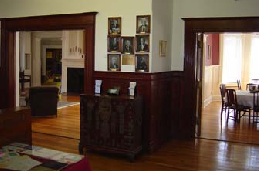“Well, I’m back.”
 First up was FEE, in a sprawling old house that has housed the organisation since the beginning. The walls are covered with historical memorabilia, such as photos of Ludwig von Mises teaching in that very building, and letters to Henry Hazlitt and Leonard Read from such folks as Ronald Reagan, John Wayne, and Leon Trotsky (this last concerning an article that Hazlitt had solicited from Trotsky during Hazlitt’s years as an editor for The Nation). And down the hall there’s a cover gallery for The Freeman; it was especially cool to see the names of Charles Johnson and Kevin Carson on the wall.
First up was FEE, in a sprawling old house that has housed the organisation since the beginning. The walls are covered with historical memorabilia, such as photos of Ludwig von Mises teaching in that very building, and letters to Henry Hazlitt and Leonard Read from such folks as Ronald Reagan, John Wayne, and Leon Trotsky (this last concerning an article that Hazlitt had solicited from Trotsky during Hazlitt’s years as an editor for The Nation). And down the hall there’s a cover gallery for The Freeman; it was especially cool to see the names of Charles Johnson and Kevin Carson on the wall.
Incidentally, the hotel where we stayed, while quite pretty, seems to have been designed by a rather deranged architect. Long corridors twist around going nowhere; the 1st and 2nd floors are also the 3rd and 4th floors; and you have to climb stairs to get between your room and the elevator (an eccentricity I had thought confined to European hotels).
 As I noted previously, the line-up for the conference was pretty anarchistic for FEE. In fact it turned out to be an even more anarchy-intensive conference than I’d thought. For example, Bryan Caplan’s talk “Less Than Minimum” was not, as I had wrongly guessed, about the minimum wage; it was about the various ways in which most states even today fall short of exercising a complete monopoly on even those functions minarchists regard as the bare minimum. One notable statistic from Bryan was that in the U.S. private police currently outnumber government police 60% to 40%. Try asking a non-anarchist sometime, “suppose we began gradually privatising the police; what do you think would happen as soon as the private police outnumbered the government police?” I’m sure they’d think the former would quickly gang up and attack the latter, and would be surprised to learn that the feared situation already exists. (Bryan argued that this showed the fundamentally peaceful nature of market anarchism. But I wonder why it’s not evidence of market failure!)
As I noted previously, the line-up for the conference was pretty anarchistic for FEE. In fact it turned out to be an even more anarchy-intensive conference than I’d thought. For example, Bryan Caplan’s talk “Less Than Minimum” was not, as I had wrongly guessed, about the minimum wage; it was about the various ways in which most states even today fall short of exercising a complete monopoly on even those functions minarchists regard as the bare minimum. One notable statistic from Bryan was that in the U.S. private police currently outnumber government police 60% to 40%. Try asking a non-anarchist sometime, “suppose we began gradually privatising the police; what do you think would happen as soon as the private police outnumbered the government police?” I’m sure they’d think the former would quickly gang up and attack the latter, and would be surprised to learn that the feared situation already exists. (Bryan argued that this showed the fundamentally peaceful nature of market anarchism. But I wonder why it’s not evidence of market failure!)
It turns out that FEE’s program director Geoffrey Lea deliberately chose speakers who would push the envelope and disagree with each other, and in fact good-natured public debates broke out between Ed Stringham and Bryan, and between me and Walter Block. (Geoff Lea had specifically introduced my talks as ones that Walter would especially disagree with; this was true enough of my first talk, “Thick Libertarianism,” but not especially of my second, “Equality: The Unknown Ideal” (despite the title), so I deliberately revised the latter as I was giving it in order to focus on more things Walter and I disagree about.) I particularly appreciated the fact that the conference allowed us to model for the students the possibility of libertarians expressing vigorous disagreement with one another without becoming unfriendly or acting like assholes.
 It was a great conference, and I’m sorry I couldn’t stay for the whole week – and especially sorry to miss Jeff Hummel’s provocatively titled talk “Why Fractional-Reserve Banking Is More Libertarian Than the Gold Standard” – but coming up next was another great conference, David Beito’s Liberty Fund symposium in Indianapolis on Zora Neale Hurston. I have some great Hurston quotes which I’ll talk about in a later post. (Incidentally, Dave sent us all a link to an audio clip of Hurston talking about zombies.) And I finally got to meet Wendy McElroy, whose work helped first introduce me, back in the 1980s, to the individualist anarchist feminists of the 19th century; she’s pretty cool. (Actually a good number of Liberty & Power bloggers were there – me, Wendy, Keith Halderman, Jonathan Bean, and my old friends Mark Brady and of course Dave B.)
It was a great conference, and I’m sorry I couldn’t stay for the whole week – and especially sorry to miss Jeff Hummel’s provocatively titled talk “Why Fractional-Reserve Banking Is More Libertarian Than the Gold Standard” – but coming up next was another great conference, David Beito’s Liberty Fund symposium in Indianapolis on Zora Neale Hurston. I have some great Hurston quotes which I’ll talk about in a later post. (Incidentally, Dave sent us all a link to an audio clip of Hurston talking about zombies.) And I finally got to meet Wendy McElroy, whose work helped first introduce me, back in the 1980s, to the individualist anarchist feminists of the 19th century; she’s pretty cool. (Actually a good number of Liberty & Power bloggers were there – me, Wendy, Keith Halderman, Jonathan Bean, and my old friends Mark Brady and of course Dave B.)
 I did finally get to the Indianapolis Museum of Art, which was excellent. They had an extremely diverse collection, including a traveling exhibition of the original typescript scroll for Jack Kerouac’s On the Road. One of my favourite pieces was a print of a white monkey by Kawabata Gyokusho (my favourite museum pieces never seem to be available as postcards, posters, or internet files!).
I did finally get to the Indianapolis Museum of Art, which was excellent. They had an extremely diverse collection, including a traveling exhibition of the original typescript scroll for Jack Kerouac’s On the Road. One of my favourite pieces was a print of a white monkey by Kawabata Gyokusho (my favourite museum pieces never seem to be available as postcards, posters, or internet files!).
I’ve been to Indianapolis many times and never knew there was a canal downtown. But then in the museum I saw this painting of a canal with the Indiana state capitol (a very cool building in its own right, by the way; it looks like it belongs in Paris) directly behind it, and thus realised that there might still be a canal just a few blocks from my hotel. Indeed there was – a bit soulless and prefab-looking these days, but still a nice place to walk.
I tried to find the Superheroes Museum, but apparently it has closed. 🙁
Next week, Mises University!